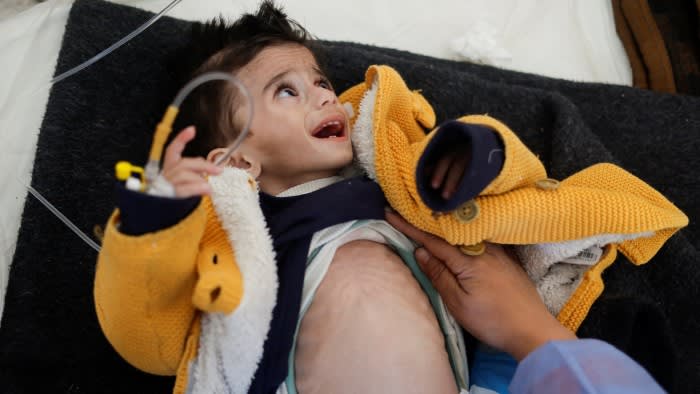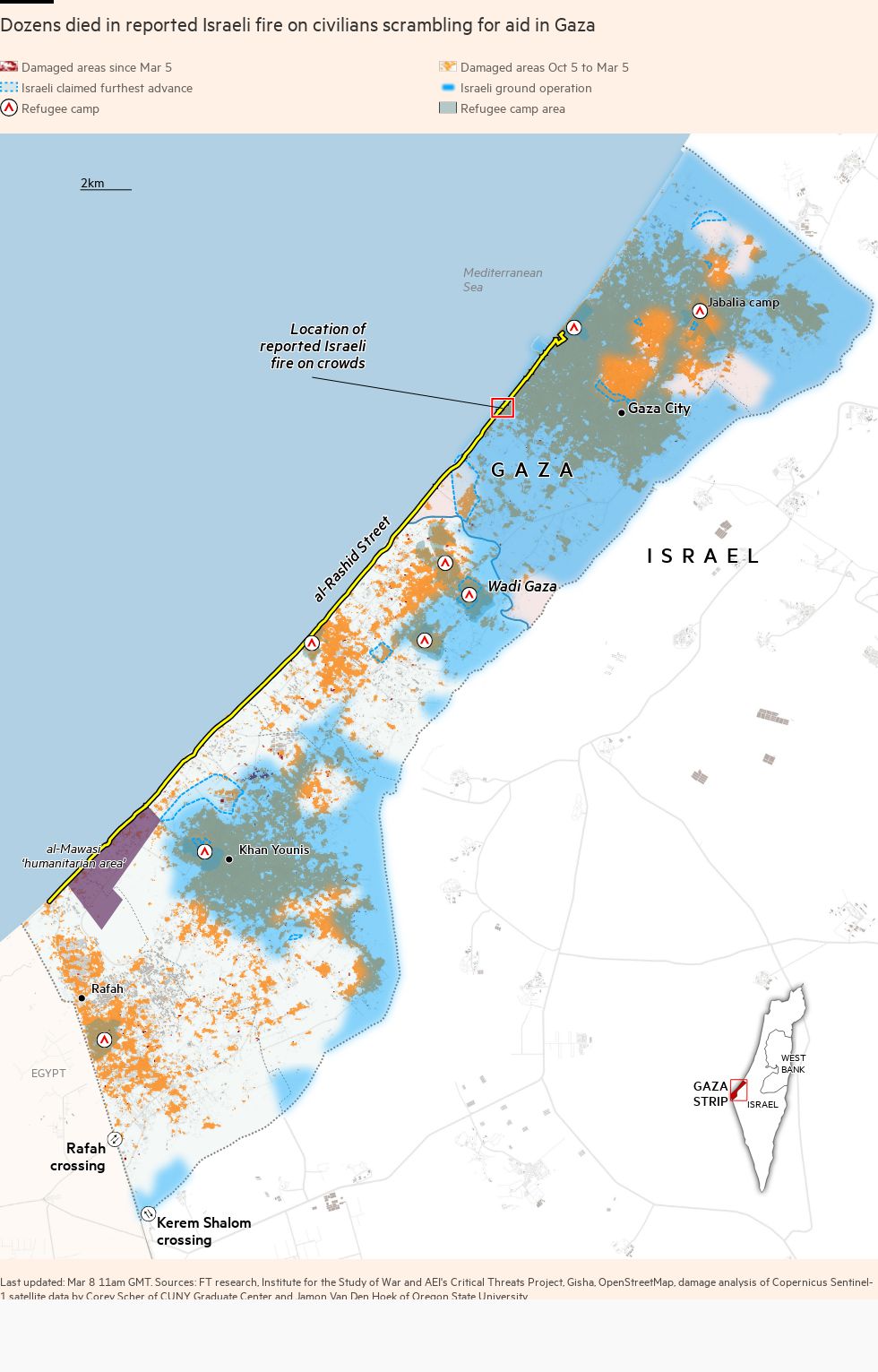Ibrahim al-Kharabishy, a Palestinian lawyer in war-ravaged northern Gaza, considered himself fortunate when he was able to bake for his hungry family with pigeon feed.
With shops largely empty and hardly any aid reaching the area, the ground feed — a mix of wheat, barley and corn — at least produced acceptable bread for his three children.
But those days are now “just a dream”, said Kharabishy. Pigeon feed all but disappeared from the market weeks ago, leaving his family to bake with ground hulls of soya beans usually used as livestock fodder.
The result was dry bread “that breaks your teeth”. His children have refused to eat it. “It is difficult for a father to hear his children crying for food,” said Kharabishy. Like many in the north, he has been reduced to scavenging for cheeseweed and grasses to boil for his children.
The Kharabishy family in Jabalia are among an estimated 300,000 people facing famine and increasingly desperate conditions in the north of the Gaza strip, a descent into hunger and starvation that has been precipitous.
Home to Gaza City with its multi-storied apartment blocks, hotels, wedding halls and much of the commercial sector, the north of the enclave was the first to be bombarded by the Israeli military, with wide swaths reduced to rubble.
As the IDF moved methodically south, it left behind a devastated landscape, cut off from the rest of the territory by Israeli checkpoints, and denied what little food enters the south by a combination of stringent Israeli restrictions, the threat of bombardment and lawlessness.
The UN has said its aid trucks are most often denied access by the Israeli military. In addition, Palestinian police refuse to secure convoys from looters because Israeli air strikes have targeted their colleagues as vestiges of the authority of Hamas, the militant group Israel is determined to eradicate.

Looters, often just hungry people, or gangs who resell the food on the black market, habitually clamber on to trucks and carry away food, preventing orderly distribution that would ensure a share for the elderly, weak and disabled, UN officials say.
“Hunger has reached catastrophic levels,” Jamie McGoldrick, the UN’s humanitarian co-ordinator for the occupied Palestinian territories, said last week after a two-day visit to Gaza. “Children are dying from hunger.”
He called for a plan to address the crisis, saying that immediate needs would include using a military access road to northern Gaza for a minimum of 300 aid trucks every day. Only six aid convoys were able to deliver to north Gaza through all of February, according to the UN.
While the US is planning to set up a pier to enable maritime deliveries to Gaza, establishing facilities that can receive substantial quantities of aid could be months away. One barge, arranged by a charity and largely funded by the United Arab Emirates, was due to leave Cyprus this weekend to test the maritime corridor. But it will only carry a fraction of Gaza’s daily aid needs.
Hunger has affected all of Gaza but the plight of those in the north has been most acute. Images of emaciated children on hospital beds circulated on social media in recent days. Gaza’s health ministry said that 18 people had so far died of hunger across the territory.
At the Kamal Adwan hospital in the north, at least 10 children were reported to have died of starvation. Hussam Abu Safieh, a paediatrician there, told the Financial Times that the children ranged in age from 25 days to 8 years.
“Their families did not have enough food or milk for them,” he said. “They arrived in an advanced state of dehydration and malnutrition, so unfortunately we lost them.”

Kharabishy in Jabalia has been training his children to eat less than their fill “so their stomachs would shrink”, he said. Jana 10, Qusay, 7 and Uday, 4 have all lost weight and his pregnant wife has been getting so little to eat that “she has no energy and can barely walk”.
The family has been surviving on a diet of instant coffee for breakfast — “it fills the children up”. Later in the day they eat boiled cheeseweed “if available”, or broth made from stock cubes.
“There has been no canned food for three months and there is no sugar,” he said. “Instead of salt, we use baking soda to season food. You can still find tomato paste and some people eat it with stock cubes.”
The World Food Programme has attempted to reach the north with little success. A 14-truck convoy was turned back by the Israeli military last week after a three-hour wait at the Wadi Gaza checkpoint. The rerouted trucks, said WFP, were later stopped by “a large crowd of desperate people who looted the food, taking around 200 tonnes”.
Israel said it had been sending privately contracted aid convoys into the north, but these are not co-ordinated with the UN and there is little information about them. On February 29, one such convoy of around 30 trucks was boarded by looters near an Israeli checkpoint south of Gaza City.
Some 120 people were killed after Israeli soldiers — who were guarding the private convoy — fired warning shots after some in the crowd approached the soldiers. Israel has acknowledged that some of them were hit by gunfire, but said that that most were trampled in a stampede. Palestinian officials and eyewitnesses have blamed the killings on troops firing into the crowds.
More than 30,000 Palestinians have died in Gaza since Israel launched its offensive, according to health officials in the enclave. The military campaign follows Hamas’s October 7 attack on Israel, which killed 1,200 people, according to Israeli officials.
As the food crisis has deepened, the US, Egypt, Jordan and other countries have resorted to air drops, which address just a fraction of the needs.
“Airdrops are a last resort and will not avert famine,” said Carl Skau, WFP deputy executive director. “We need entry points to northern Gaza that will allow us to deliver enough food for half a million people in desperate need.”

Among those running short of supplies in the north are hundreds of Palestinian Christians who have been holed up in two churches in Gaza City.
Ramy Tarazi, who is in the Greek Orthodox Church of Saint Porphyrius, said they had been unable to secure any of the aid that had managed to reach the enclave. For sustenance, they rely on bread made from barley and corn used for fodder, along with occasional food donations from charities.
They can still access some water from a well in the church, but fuel to pump it is scarce and expensive, he said. The group have been sheltering in the church for around 150 days.
“I am about to run out of milk for my 1-year-old son, and there are five other small children in the church who need milk,” he said. “If you find anything on the market, it is more expensive than if we lived in Switzerland.”
All the food still available in shops was completely unaffordable, said Mohamed Awny, a father of five who last week made the journey to Rafah, the southern town swollen by more than 1mn displaced people.
“A kilogramme of potatoes costs around $12, while a kilogramme of Egyptian rice is around $28,” he said. In the north his family was surviving on “one meal a day at around 4pm”.
His 9-year-old son, Awny said, “longed for sweets that are simply not there”.

